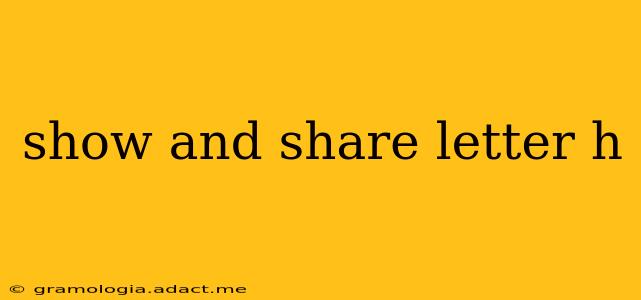Show and Share the Letter H: A Comprehensive Guide for Educators and Parents
Learning the alphabet is a foundational step in a child's educational journey. The letter H, with its unique shape and sound, often presents both challenges and opportunities for young learners. This guide will explore various methods for effectively teaching and reinforcing the letter H, catering to different learning styles and developmental stages.
Why is Learning the Letter H Important?
Mastering the alphabet is crucial for reading and writing development. The letter H, while seemingly simple, plays a vital role in building phonetic awareness and vocabulary. Children who grasp the letter's sound and form early on gain a head start in literacy skills. Understanding the letter H lays the groundwork for successfully decoding words containing the "h" sound, contributing to improved reading comprehension and overall academic success.
How to Teach the Letter H: A Multi-Sensory Approach
Effective teaching goes beyond rote memorization. A multi-sensory approach engages different learning styles, fostering deeper understanding and retention. Here are some engaging strategies:
-
Visual Learning: Use flashcards with uppercase and lowercase "H"s, incorporating different fonts and colors. Show pictures of objects starting with "H" (hat, house, hippo). Trace the letter H in the air, then on paper using different textures like sand, shaving cream, or finger paint.
-
Auditory Learning: Sing alphabet songs focusing on the "H" sound. Repeat the sound "h-h-h" while emphasizing the breathy quality. Use alliteration, saying phrases like "Happy hippo hopped happily."
-
Kinesthetic Learning: Create the letter H using the child's body. Have them lie on the ground and form the letter with their limbs. Use building blocks or other manipulatives to construct the shape of an H.
What Sounds Does the Letter H Make?
The letter H is unique because it doesn't make a sound on its own. Instead, it modifies the sound of the vowel that follows it. It's often described as a "silent letter" at the start of words, but it affects how the following vowel is pronounced. This is a crucial concept for young learners to grasp.
How Do You Incorporate H into Daily Activities?
Learning doesn't have to be confined to the classroom or a formal setting. Integrating the letter H into everyday routines makes learning fun and engaging:
- Household Hunts: Go on a "H hunt" around the house, identifying objects beginning with "H".
- Story Time: Read books with words starting with "H", pointing out the letter and its sound.
- Creative Activities: Draw pictures of things beginning with "H", and label them. Use playdough or clay to form the letter.
Games to Practice the Letter H:
Games make learning more interactive and enjoyable. Here are a few ideas:
- H-Sound Bingo: Create bingo cards with pictures of objects starting with "H". Call out the sounds, and children mark the corresponding pictures.
- H-Word Search: Create a simple word search with words beginning with "H".
- H-Letter Matching: Match uppercase and lowercase "H"s.
Examples of Words Starting With H:
This list helps solidify understanding of the letter H in various contexts:
- Hat
- House
- Horse
- Hand
- Hippopotamus
- Heart
- Happy
- Honey
By employing these multifaceted techniques, educators and parents can effectively and engagingly introduce and reinforce the letter H, fostering a love of learning and building a strong foundation for future literacy success. Remember to adapt the methods to the child's age and learning style for optimal results.
